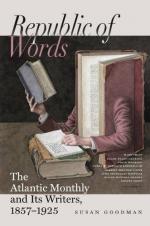An American ought to value Richter’s books for the causes which made them repulsive to all social and literary cliques. The exquisite art, and the wise, clear mind of Goethe need not come into contrast, to disable us from giving Richter the reception which alone he would value or command. Nor is it necessary to deny that the frequent intercalations and suspensions of his narrative, racy and suggestive as they are, and overflowing with feeling, will fret a modern reader who is always “on time,” like an express-man, and is quite as regardless of what may be expressed.
“Titan” is not a novel in the way that Charles Reade’s, or Eugene Sue’s, or Victor Hugo’s books are novels. The nearest English model, in the matter of style and quaint presuming on the reader’s patience, is Sterne. But if one wishes to see how Richter is not sentimental, in spite of his incessant and un-American emotion, let him read Sterne, and hasten then to be embraced by Richter’s unsophisticated feeling, which is none the less refreshing because it is so exuberant and has such a habit of pursuing all his characters. And where else, in any language, is Nature so worshipped, and so rapturously chased with glowing words, as some young Daphne by some fiery boy?
Neither are there any characters in this novel, in the sense of marked idiosyncrasies, or of the subtile development of an individual. Sometimes Richter’s men and women are only the lay-figures upon which he piles and adjusts his gorgeous cloth-of-gold and figured damask. But Siebenkaes and his wife, in “Flower-, Fruit-, and Thorn-Pieces,” are characters, quite as much as any of Balzac’s nice genre men and women, and on a higher plane. Richter uses his persons of both sexes principally to express the conditions of his feeling; they are cockles, alternately dry and sparkling, underneath his mighty ebb and flow.
On one point we doubt if the American mind will understand Richter. He believed in a love that one man might have for another man, which as little corresponds to the average idea of friendship as the anti-slavery sentiment of the “People’s party” corresponds to Mr. Garrison’s. In this respect Richter creates an ideal and interfuses it with all his natural ardor, which a German can understand better than the men of any other nation, for in him is the tendency that Richter seeks to set forth by his passionate imagination. Orestes and Pylades, David and Jonathan, and the other famous loves of men, are suspected by the calculating breeds of people. Brother Jonathan seldom finds his David, and he doubtless thinks the Canon ought to have transferred that Scriptural friendship into the Apocrypha. We shall sniff at the highly colored intercourse of Richter’s men, for it is often more than we can do to really love a woman. We shall pronounce the relation affected, and the expression of it turgid, even nauseous. But there is a genuine noble pulse in the German heart, which beats to the rhythm of two men’s heroic attachment, and can expand till all the blood that flows through Richter’s style is welcomed and propelled by it. Still, we think that the unexpressed friendship may also stand justified before the ideal.




